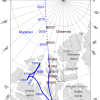True North vs. Magnetic North
In 1908, US Navy engineer Robert Peary claimed to be the first person to reach the North Pole. Equipped only with wooden sleds and dogs, Peary and his team trekked across the frozen waters of the Arctic Ocean, arriving at the point in early April. However, Peary’s claim has been met with much skepticism. Many critics say the team was not equipped with enough navigational instruments, others say Peary was simply lying.
Two North Poles?
But there is another discrepancy for which we must account. That is to say, which North Pole did Peary allegedly discover? As it turns out, there are actually two North Poles on planet Earth. What Peary and other explorers sought to discover was True North, also known as terrestrial or geographic North. This is a fixed point in the middle of the Arctic Ocean at 90°N latitude. Here, every direction is south. While this point helps us justify maps and gives Santa Claus a place to live, it has little bearing on Earth’s geologic history.
For that we must turn to Magnetic North. Unlike True North, Magnetic North depends on more than just cartography. Magnetic North is the point where the Earth’s magnetic field points straight south. In other words, it Earth is a giant magnet (which it is), magnetic north is the true north pole, directly opposite of the south pole like on any bar magnet.
What Does Magnetic North Do?
As it turns, Magnetic North is much more important than True North. The Magnetic North pole is also known as a “dip pole” and, along with Magnetic South, is where the Earth’s magnetic field is at its weakest. This is one reason the auroras borealis and australis are more visible closer to their respective ends of the Earth. Auroras are created by solar wind, but the Earth’s magnetosphere usually deflects them before they can close enough to do any damage. At Magnetic North, they are able to get much closer and light particles are scrambled in Earth’s atmosphere. Thus, the Northern Lights are born.
Perhaps one of the most significant things about Magnetic North, is its effect on navigation. When you use a compass, the needle is attracted to Magnetic North, not True North. That means if you walk in the northerly direction indicated by your compass, you’ll wind up miss the True North Pole by a few hundred miles! The only time a compass will point to True North is when it is directly in line with Magnetic North. This is called declination. To take advantage of this, you’d have to start your journey in the middle of Lake Superior!
Set Adrift
Another key way Magnetic North differs from True North is that its location actually moves! True North is so named because it never moves. It will always be at 90°N latitude. However, Magnetic North is free to roam. The polar shift is due to changes in magnetic activity deep within the Earth’s core. As the core’s magnetic field shifts, so does the pole. The image above shows just how drastically has shifted. While it is currently situated off the coast of Canada’s Ellesmere Island, by 2020, Magnetic North is expected to drift as far away as Russia. This phenomenon is known as Polar Drift.
While we don’t advise attempting to walk to the Magnetic North pole, you can still test directions and Earth’s magnetism by building your own compass. Learn how in an earlier post!
Image by Cavit

